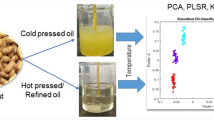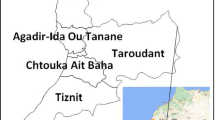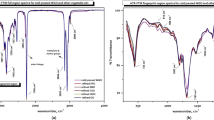Abstract
Edible oils are essential components in a human being’s diet due to their rich flavor and nutritional values. In India, the use of sunflower (Helianthus annuus) oil has increased because of its unique qualities, such as having good polyunsaturated fatty acids and less mono-unsaturated fatty acids. Sunflower oil is a highly nutritious edible oil is likely to be adulterated with cheap oils like Palm oil due to the increase in demand. In this paper, the problem of sunflower oil adulteration with palm oil is studied using attenuated total reflection (ATR) mid-infrared spectroscopy. Using laboratory-made adulterated samples as a reference, ATR spectroscopy (wavenumber range 1781 to 915 cm−1) combined with chemometrics was successful in detecting the presence of palm oil in sunflower oil and predicting the adulteration proportions. Applying principal component analysis (PCA), distinguishable clusters of pure and adulterated samples were realized. Multiple wave number ranges associated with various functional groups (1781–1680 cm−1, 1490–919 cm−1), and some ranges from PCA correlation loading plot were selected for further analysis. Classification of pure and adulterated samples was accomplished employing partial least square discrimination analysis and soft independent modeling of class analogy, with classification efficiency of 100 percent and 90 percent, respectively. For quantitative prediction, the partial least squares regression method on selected wavenumber range data was applied. The coefficient of determination (R2) for calibration and validation was observed to be 0.98. This study showed ATR-based Mid-infrared spectroscopy’s potential for the detection of palm oil adulteration in sunflower oil even at a minimum of 5% adulteration.












Similar content being viewed by others
References
Y.H. Chong and T.K.W. Ng, Effects of palm oil on cardiovascular risk, Med. J. Malays., 46(1991) 41–50.
D.O. Edem, Palm oil: biochemical, physiological, nutritional, hematological, and toxicological aspects: a review, Plant Foods Hum. Nutr., 57(2002) 319–341. https://doi.org/10.1023/a:1021828132707. PMID: 12602939.
R. Aparicio and R Aparicio-Ruíz, Authentication of vegetable oils by chromatographic techniques, J. Chromatogr. A, 881(2000) 93–104.
C. Xing, X. Yuan, X. Wu, X. Shao, J. Yuan and W. Yan, Chemometric classification and quantification of sesame oil adulterated with other vegetable oils based on fatty acids composition by gas chromatography, LWT, 108(2019) 437–445.
L. Zhang, P. Li, X. Sun, X. Wang, B. Xu, X. Wang, F. Ma, Q. Zhang and X. Ding, Classification and adulteration detection of vegetable oils based on fatty acid profiles, J. Agric. Food Chem., 62(2014) 8745–8751.
S. Mildner-Szkudlarz and H.H. Jeleń, The potential of different techniques for volatile compounds analysis coupled with PCA for the detection of the adulteration of olive oil with hazelnut oil, Food Chem., 110(2008) 751–761.
R. Malekahmadi, S.A. Yasini Ardakani, A. Sadeghian and H. Eslami, Rapid detection of adulteration in mixing sesame, sunflower, and canola vegetable oils by mathematical model, Food Anal. Methods, 14(2021) 1456–1463.
J. Gardener, Electronic tongues, In: IEE Conference Publication, Wiley, (2005) pp. 169–194.
M. Bougrini, K. Tahri, Z. Haddi, T. Saidi, N. El Bari and B. Bouchikhi, Detection of adulteration in argan oil by using an electronic nose and a voltammetric electronic tongue, J. Sens., 2014(2014).
I.M. Apetrei and C. Apetrei, Detection of virgin olive oil adulteration using a voltammetric e-tongue, Comput. Electron. Agric., 108(2014) 148–154.
P. Oliveri, M.A. Baldo, S. Daniele and M. Forina, Development of a voltammetric electronic tongue for discrimination of edible oils, Anal. Bioanal. Chem., 395(2009) 1135–1143.
Z. Hai and J. Wang, Electronic nose and data analysis for detection of maize oil adulteration in sesame oil, Sens. Actuators B Chem., 119(2006) 449–455.
M.C. Cerrato Oliveros, J.L. Pérez Pavón, C. García Pinto, M.E. Fernández Laespada, B. Moreno Cordero and M. Forina, Electronic nose based on metal oxide semiconductor sensors as a fast alternative for the detection of adulteration of virgin olive oils, Anal. Chim. Acta, 459(2002) 219–228.
A.M. Marina, Y.B. Che Man and I. Amin, Use of the SAW sensor electronic nose for detecting the adulteration of virgin coconut oil with RBD palm kernel Olein, J. Am. Oil Chem. Soc., 87(2010) 263–270.
K.N. Basri, M.N. Hussain, J. Bakar, Z. Sharif, M.F.A. Khir and A.S. Zoolfakar, Classification and quantification of palm oil adulteration via portable NIR spectroscopy, Spectrochim. Acta Part A Mol. Biomol. Spectrosc., 173(2017) 335–342.
C. Gertz, B. Matthäus and I. Willenberg, Detection of soft-deodorized olive oil and refined vegetable oils in virgin olive oil using near infrared spectroscopy and traditional analytical parameters, Eur. J. Lipid Sci. Technol., 122(2020) 1900355.
Z. Yuan, L. Zhang, D. Wang, J. Jiang, P.D.B. Harrington, J. Mao, Q. Zhang and P. Li, Detection of flaxseed oil multiple adulteration by near-infrared spectroscopy and nonlinear one class partial least squares discriminant analysis, LWT, 125(2020) 109247.
X. Li, et al., Review of NIR spectroscopy methods for nondestructive quality analysis of oilseeds and edible oils, Trends Food Sci. Technol., 101(2020): 172–181.
C.A. Nunes, Vibrational spectroscopy and chemometrics to assess authenticity, adulteration and intrinsic quality parameters of edible oils and fats, Food Res. Int., 60(2014): 255–261.
G. Akin, Ş.N. Karuk Elmas, F.N. Arslan, İ Yılmaz and A. Kenar, Chemometric classification and quantification of cold pressed grape seed oil in blends with refined soybean oils using attenuated total reflectance–mid infrared (ATR–MIR) spectroscopy, LWT, 100(2019) 126–137.
Y. Li, Y. Xiong and S. Min, Data fusion strategy in quantitative analysis of spectroscopy relevant to olive oil adulteration, Vib. Spectrosc., 101(2019) 20–27.
O. Uncu and B. Ozen, A comparative study of mid-infrared, UV–Visible and fluorescence spectroscopy in combination with chemometrics for the detection of adulteration of fresh olive oils with old olive oils, Food Control, 105(2019) 209–218.
T. Parker, et al., 60 MHz 1H NMR spectroscopy for the analysis of edible oils, TrAC Trends Anal. Chem., 57(2014) 147–158.
J. Tan, R. Li, Z.T. Jiang, S.H. Tang, Y. Wang, M. Shi, Y.Q. Xiao, B. Jia, T.X. Lu and H. Wang, Synchronous front-face fluorescence spectroscopy for authentication of the adulteration of edible vegetable oil with refined used frying oil, Food Chem., 217(2017) 274–280.
I. Sota-Uba, M. Bamidele, J. Moulton, K. Booksh and B.K. Lavine, Authentication of edible oils using fourier transform infrared spectroscopy and pattern recognition methods, Chemom. Intell. Lab. Syst., 210(2021) 104251.
R. Jamwal, S. Kumari, B. Balan, S. Kelly, A. Cannavan and D.K. Singh, Rapid and non-destructive approach for the detection of fried mustard oil adulteration in pure mustard oil via ATR-FTIR spectroscopy-chemometrics, Spectrochim. Acta Part A Mol. Biomol. Spectrosc., 244(2021) 118822.
J.R. Amit, S. Kumaria, A.S. Dhaulaniya, B. Balan and D.K. Singh, Application of ATR-FTIR spectroscopy along with regression modelling for the detection of adulteration of virgin coconut oil with paraffin oil, LWT, 118(2020) 108754.
IS 548–1: Methods of sampling and test for oils and fats, Part I: methods of sampling, physical and chemical tests: Bureau of Indian Standards: Free Download, Borrow, and Streaming: Internet Archive https://archive.org/details/gov.in.is.548.1.1964 (19 April 2021).
R. Bro and A.K. Smilde. Principal component analysis, Anal. Methods 6(2014) 2812–2831.
D. Ballabio and V. Consonni, Classification tools in chemistry. Part 1: linear models. PLS-DA, Anal. Methods 5(2013) 3790–3798.
S. Wold, M. Sjöström and L. Eriksson, PLS-regression: a basic tool of chemometrics, Chemom. Intell. Lab. Syst. 58(2001) 109–130.
N. Upadhyay, P. Jaiswal and S.N. Jha, Detection of goat body fat adulteration in pure ghee using ATR-FTIR spectroscopy coupled with chemometric strategy, J. Food Sci. Technol., 53(2016) 3752–3760.
Acknowledgements
The authors are thankful to Director CSIR-Central Electronics Engineering Research Institute (CSIR-CEERI), Pilani, India, for allowing us to do experimental work and access software packages required for analysis. The authors are also thankful to Director Birla Institute of Technology and Sciences (BITS) Pilani.
Author information
Authors and Affiliations
Corresponding author
Additional information
Publisher's Note
Springer Nature remains neutral with regard to jurisdictional claims in published maps and institutional affiliations.
Rights and permissions
About this article
Cite this article
Srinath, K., Kiranmayee, A.H., Bhanot, S. et al. Detection of Palm Oil Adulteration in Sunflower Oil Using ATR-MIR Spectroscopy Coupled with Chemometric Algorithms. MAPAN 37, 483–493 (2022). https://doi.org/10.1007/s12647-022-00558-1
Received:
Accepted:
Published:
Issue Date:
DOI: https://doi.org/10.1007/s12647-022-00558-1




